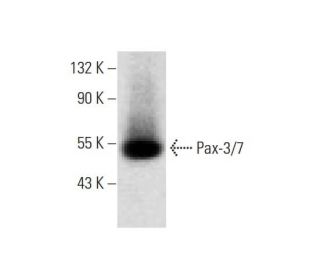


C32 nuclear extract: sc-2136
- supplied in four vials, each containing 250 µg nuclear extract in 50 µl buffer
- provided in 20 mM HEPES (pH 7.9), 20% v/v glycerol, 0.1 M KCI, 0.2 mM EDTA, 0.5 mM PMSF and 0.5 mM DTT
- human nuclear extract; amelanotic melanoma cells
- suitable for use in Gel Shift and Western Blotting assays
- Extracts should be stored at -70°C and repeated freezing and thawing should be avoided.
- prepared by the method of Dignam et al., (1983) Nucleic Acids Res. 11: 1475
QUICK LINKS
SEE ALSO...
The C32 nuclear extract is produced from the C32 cell line, a line of human melanoma cells frequently used in biological research to study the molecular and cellular mechanisms of melanoma, a form of skin cancer. Originating from malignant melanocytes, these cells provide a valuable tool for studying cancer cell biology in a controlled laboratory setting. The nuclear extract itself comprises a diverse array of proteins and nucleic acids that reside within the nucleus, including transcription factors, DNA-binding proteins, and other regulatory molecules involved in gene expression and chromatin structure. Researchers use the C32 nuclear extract to investigate genetic regulation, signal transduction pathways, and the role of nuclear proteins in the development and progression of melanoma. By analyzing this extract, scientists can gain a deeper understanding of the nuclear dynamics that occur in melanoma cells, such as changes in transcriptional activity, modifications in chromatin architecture, and interactions among nuclear proteins. These studies help explain the complex biological processes that characterize melanoma and provide insights into the fundamental aspects of cancer biology, focusing on how alterations in nuclear components can influence the behavior and fate of cancer cells.
C32 nuclear extract References:
- Hepatic gene expression changes in hypothyroid juvenile mice: characterization of a novel negative thyroid-responsive element. | Dong, H., et al. 2007. Endocrinology. 148: 3932-40. PMID: 17463053
- 3,3′,5-Triiodo-L-thyronine inhibits ductal pancreatic adenocarcinoma proliferation improving the cytotoxic effect of chemotherapy. | Michienzi, S., et al. 2007. J Endocrinol. 193: 209-23. PMID: 17470512
- Flanking sequences for the human intercellular adhesion molecule-1 NF-kappaB response element are necessary for tumor necrosis factor alpha-induced gene expression. | Paxton, LL., et al. 1997. J Biol Chem. 272: 15928-35. PMID: 9188493
Ordering Information
| Product Name | Catalog # | UNIT | Price | Qty | FAVORITES | |
C32 nuclear extract | sc-2136 | 250 µg/0.05 ml | $160.00 |
